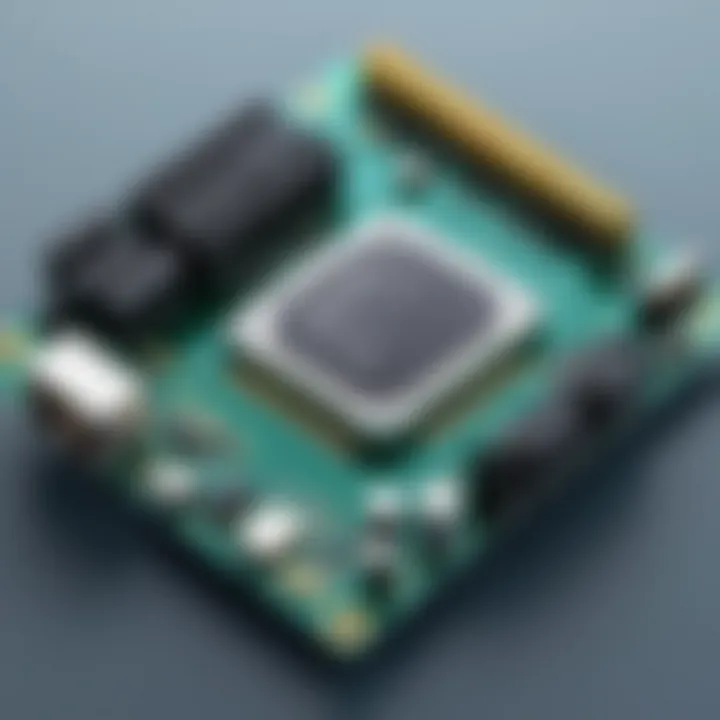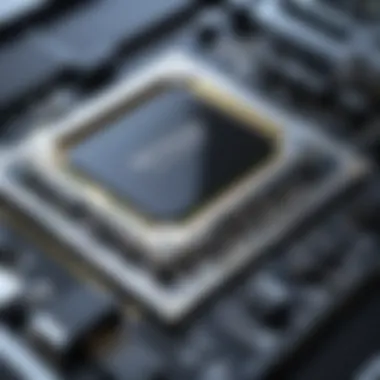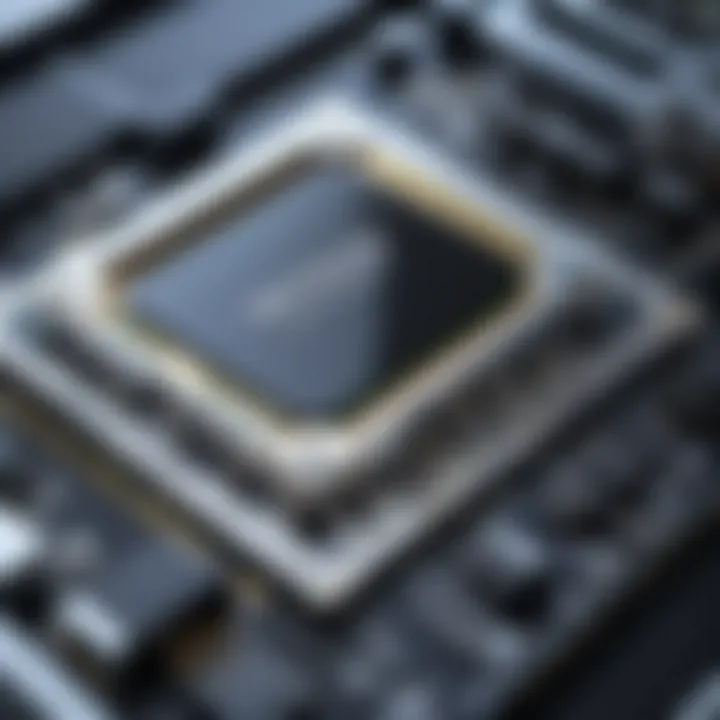Mastering DotMemory: A Guide to Downloading and Usage


Intro
In today’s fast-paced tech environment, memory management stands as a critical pillar for building efficient software applications. As developers and IT professionals dive deeper into the realms of cloud computing, data analytics, and software development, tools like DotMemory become indispensable. This exploration sheds light on DotMemory—a sophisticated tool designed to help professionals assess and optimize memory usage in .NET applications. By understanding how to effectively download, install, and leverage this tool, tech enthusiasts can enhance application performance and ultimately deliver a better end-user experience.
Overview of Software Development and Memory Profiling Tools
Memory profiling isn’t just a buzzword; it’s the backbone of robust software development. Developers often face challenges related to memory leaks, inefficient memory usage, and performance bottlenecks. Here, DotMemory fits in, offering a suite of functionalities that aim to streamline these issues.
Definition and Importance of DotMemory
DotMemory is a powerful memory profiling tool from JetBrains that allows developers to analyze the memory consumption of .NET applications. It provides insights into memory allocation, usage patterns, and potential leaks, crucial for optimizing application performance. By employing such a tool, developers can ensure their applications run smoothly, significantly affecting both functionality and user satisfaction.
Key Features and Functionalities
- Memory Snapshot Analysis: Capture memory states at various points in time to discern differences and identify issues.
- Automatic Memory Leak Detection: Harnesses intelligent algorithms to pinpoint areas where memory is not being released effectively.
- Visual Representation: Offers a variety of graphs and charts for quick understanding and analysis of memory usage.
- Integration: Seamlessly fits within Visual Studio, allowing for in-environment diagnostics and analysis.
Use Cases and Benefits
DotMemory is not just another tool; it’s a benefit-driven solution for various scenarios such as:
- Debugging Memory Leaks: Quickly identify and fix memory leaks before they become critical bugs.
- Performance Optimization: Analyze memory utilization patterns to optimize resource management.
- Support for Legacy Systems: Can be utilized to modernize older .NET applications by uncovering latent memory issues.
"Effective memory profiling can make the difference between a mediocre application and a groundbreaking one."
Best Practices for Using DotMemory
When delving into DotMemory, a strategic approach is essential. Here are some industry best practices to keep in mind:
Implementing DotMemory
- Regular Profiling: Make it a habit to profile your application routinely, especially after significant changes.
- Benchmarking Performance: Use DotMemory to establish benchmarks for memory consumption across different versions of your application.
Tips for Maximizing Efficiency
- Prioritize Hot Paths: Focus on profiling sections of code that are called frequently or handle critical operations early on.
- Collaborate with Team Members: Share findings with team members to promote a collective understanding of memory management practices.
Common Pitfalls to Avoid
- Neglecting Snapshot Comparison: Always compare snapshots post-changes to catch any new issues proactively.
- Overlooking Documentation: Utilize DotMemory’s documentation for deeper insights into specific features and functions.
How-To Guides and Tutorials
To get started with DotMemory effectively, follow these structured guides for optimal utilization.
Installation Steps
- Download the Installer: Visit the JetBrains website to procure the latest version of DotMemory.
- Follow the Setup Instructions: Execute the setup wizard and adhere to the prompts to install the tool.
- Integration with Visual Studio: Enable the DotMemory plug-in through Visual Studio, facilitating in-environment memory analysis.
Step-by-Step Guides for Various Users
- Beginners: Start with simple memory snapshots to understand basic functionality.
- Advanced Users: Explore customization options for insights tailored to specific performance needs.
By embracing DotMemory, software professionals can not only enhance their applications’ quality but also streamline their development process, making the most out of their resources as they work through the increasingly complex landscape of memory management.
Intro to DotMemory
Understanding DotMemory is crucial for anyone aiming to enhance their application's memory management. This tool stands out amongst its peers because it offers insightful analytics into how memory is utilized, enabling developers and IT professionals to optimize their software performance. With DotMemory, no longer are you left in the dark about memory consumption—its comprehensive profiling capabilities shine a light on areas that require attention and improvement.
Overview of Memory Profiling Tools
Memory profiling tools serve an essential function in the development process, acting as a magnifying glass on your application's memory usage. Among various tools like JetBrains' DotMemory, Visual Studio Diagnostic Tools, and more, each has its strengths and quirks. DotMemory, for example, is particularly strong at pinpointing memory leaks and examining the memory impact of different objects within the application. While many developers may rely on basic monitoring solutions, having a dedicated profiling tool can provide clarity and deeper insights.


In practical terms, tools like DotMemory can help developers understand how different components interact and consume memory over time. By tracking allocations and deallocations, users can identify inefficient patterns that might otherwise displace valuable resources. For those in high-stakes environments, this means enhancing performance, preventing application crashes, and improving user experiences by ensuring that applications run smoothly without unnecessary slowdowns.
Importance of Memory Management
Effectively managing memory is akin to maintaining a balance sheet in accounting; it's critical for the health of any software application. Memory mismanagement can lead to a plethora of problems including slow performance, unresponsive interfaces, or even crashes. These issues not only frustrate users but can also lead to significant long-term costs in churn and unplanned downtimes for businesses.
"Memory leaks are like tiny holes in a boat; if you don’t patch them up, you can sink without a trace."
Incorporating proper memory management practices into the development lifecycle is, hence, non-negotiable. With tools like DotMemory at your disposal, you can assess your strategies and make informed adjustments. From understanding how objects are retained to discovering where excessive allocation occurs, memory management becomes less of a guessing game and more about data-driven decisions. Ultimately, nurturing a culture of vigilant memory management reflects a commitment to quality, performance, and user satisfaction.
Downloading DotMemory
The process of downloading DotMemory forms the cornerstone of any endeavor to enhance memory management within your applications. This tool is not just about crunching numbers; it’s about gaining that granular insight into how your application behaves under various conditions. With a steady rise in the complexity of software applications, efficient memory usage has become paramount. Understanding how to effectively download and install DotMemory is key for developers and IT professionals aiming to tackle memory inefficiencies head-on.
Once you’ve set your sights on DotMemory, you’ll find that the journey involves more than a mere click of a button. It’s essential to ensure that your system meets the prerequisites and that the version you choose aligns with your project requirements. Let’s not beat around the bush: a wrong step here can lead to a ripple effect of issues down the lane. Thus, examining the key aspects of downloading DotMemory is not only beneficial, it’s vital.
Official Sources for Download
When it comes to downloading DotMemory, always stick to the official sources. This not only guarantees the authenticity of the software, but it also reduces the chances of downloading malware. JetBrains provides DotMemory directly on their official website, and it’s wise to make that your go-to destination. You can visit their site here for the latest version.
Additionally, always watch for updates; JetBrains is known to roll out patches and enhancements frequently. Keeping your tool updated ensures that you have access to the latest features and bug fixes, which can significantly impact your profiling experience.
System Requirements for Installation
Before diving into the installation process, understanding system requirements saves you a bucket load of hassle. Installation issues often arise not from the tool itself but from mismatches in system configurations. Here are some critical requirements you should look at:
- Operating System: DotMemory is compatible with various operating systems, but verify if your version aligns with the tool's requirements. Commonly supported ones include Windows, macOS, and Linux.
- RAM and CPU: While it’s easy to assume your machine can handle the software, a good rule of thumb is to have at least 4GB of RAM and a dual-core processor to comfortably run memory profiling tasks.
- .NET Framework: If your application is built on .NET, ensure that the proper version of the .NET framework is installed. Incompatibilities here can lead to poor profiling results.
Before downloading, make sure your machine meets these specifications or does more than what you need; it’s not rocket science, just good practice.
Choosing the Right Version
The choice of version might sound straightforward, but it’s packed with implications. DotMemory typically offers various editions, each catering to different user needs. Get it wrong, and you could find yourself in a quagmire later on.
- Trial vs. Commercial: If you're new to DotMemory, the trial version might be your best bet. It allows you to explore features without committing financially. Just remember, it’s time-bound!
- Feature Set: Different iterations of DotMemory might feature unique functionalities. Familiarize yourself with each version’s offerings so that you select one that supports your specific profiling needs.
- Update Frequency: Look out for regular updates on the official site. Choosing a version with frequent updates can streamline your memory profiling experience, keeping you on the cutting edge of new features.
Installation Process
The installation process of DotMemory is a crucial aspect for developers and IT professionals. Getting it right from the start can make all the difference when it comes to effectively profiling memory usage and diagnosing performance issues. A well-executed installation not only ensures that the software operates as intended but also saves time and headache down the line.
When it comes to downloading and installing DotMemory, a few elements stand out. Firstly, understanding the system requirements is essential. If a system isn't adequately equipped, it might lead to hindered performance or even installation errors. Secondly, familiarizing oneself with the installation steps ensures a smoother setup.
Ultimately, a sound installation process lays the foundation for the powerful functionalities DotMemory offers in memory profiling. With the right setup, developers can start maximizing their application’s performance without running into initial hurdles that could be avoided or mitigated.
Step-by-Step Installation Guide
Installing DotMemory involves several straightforward steps:
- Download DotMemory: Visit the official JetBrains website to get the latest version of DotMemory. Ensure you select the version that aligns with your operating system requirements.
- Run the Installer: Once downloaded, find the installer file, usually located in your downloads folder. Double-click to execute it.
- Accept the License Agreement: A prompt for the license agreement will appear. Review the terms and, if you agree, continue the process by clicking ‘Next.’
- Choose Installation Directory: Decide where you want DotMemory to be installed. The default directory is usually fine, but you can pick a custom folder if you prefer.
- Select Configuration Options: Depending on your needs, you can choose whether to create shortcuts or associate DotMemory with particular file types.
- Complete the Installation: Finally, click ‘Install’ and wait for the installation to finish. Once done, launch DotMemory to verify that everything is working properly.
"A smooth installation of DotMemory is like setting a solid foundation; it makes the entire profiling experience more rewarding."
Common Installation Issues
Even with a detailed installation guide, issues can crop up occasionally. Here are some common installation hurdles and how to address them:
- Failed Installation: This can occur if the system doesn’t meet DotMemory's minimum requirements. Before starting the installation, double-check the requirements, including OS version and available RAM.
- Installer Not Responding: Sometimes, the installer may freeze up. A simple solution may be to restart the computer and try launching the installer again.
- Antivirus Interference: Occasionally, security software may block the installation process. Disabling your antivirus momentarily can sometimes allow for a smooth installation.
- Incomplete Installation: If the installation doesn’t complete for any reason, try uninstalling the partially installed version and running the installation again.
- Configuration Issues: If there’s initial trouble launching the software or functionality seems limited, ensure all configuration options were set correctly during the installation phase.
By being aware of these common pitfalls, users can better navigate the installation phase, making their journey into memory profiling with DotMemory less cumbersome.
User Interface Overview
Understanding the user interface of DotMemory is crucial for unlocking its full potential. A streamlined, intuitive UI can make the difference between effective memory profiling and a frustrating experience. When developers have a solid grasp of the interface, they can quickly navigate through its functionalities without feeling like they're wandering in a maze.


The design elements of DotMemory enhance usability by incorporating shortcuts and visual indicators that facilitate quick action. Users can go from monitoring memory allocations to analyzing snapshots with minimal clicks. Key metrics are displayed prominently, ensuring that vital data is always at hand. Moreover, the customizable settings for the UI allow users to tailor their experience to fit their workflow preferences. This minimizes distractions, allowing developers to focus on what really matters – improving application performance.
Navigating the DotMemory UI
Navigating the DotMemory interface involves familiarizing oneself with its various panels and functions. When you first launch DotMemory, you are greeted with a dashboard that summarizes your current memory usage, snapshot availability, and ongoing profiling sessions. The layout is designed to be user-friendly, ensuring that even those who are not tech-savvy can find their way around.
Here is what you can expect while navigating:
- Dashboard: This serves as your command center. Essential metrics are displayed right off the bat. Users can quickly access important functions like starting a new profiling session.
- Profiling Sessions: Several buttons make it easy to start or stop profiling. Users can also see any sessions they have run recently, allowing for a quick return to past work.
- Navigation Pane: This is where users will drill down into specific analysis modes. It can seem overwhelming at first, but familiarity breeds confidence.
To make the navigation experience smoother, creating mental shortcuts can be helpful. For instance, keyboard shortcuts for common tasks can save precious time during a profiling session.
Key Features of the Interface
The DotMemory interface boasts several features designed to enhance user experience and improve the effectiveness of memory analysis. Here are some of the standout elements:
- Snapshot Comparison: Users can take snapshots at different points to analyze memory changes over time. This feature is critical for spotting memory leaks, as it allows for an easy side-by-side comparison.
- Memory Allocation Details: Clicking on various metrics will reveal detailed information about memory allocations, helping to identify the culprits behind large memory footprints.
- CPU Usage Tracking: The UI also integrates CPU usage data, allowing users to correlate memory issues with potential performance bottlenecks.
- Reports Generation: Users can generate and export reports of their findings directly from the interface. This capability saves time by automating the compilation of metrics and insights.
A well-designed UI is not just about aesthetics; it's about functionality. The right features elevate a tool from simple to indispensable.
Mastering the interface will not only enhance your efficiency but also empower you to extract the most out of DotMemory. Repeated use will pave the way for a deeper understanding of each metric and report, thereby placing valuable insights at your fingertips.
Memory Profiling with DotMemory
Memory profiling is a crucial practice in software development, especially when building high-performance applications. It involves analyzing the memory usage of applications to identify inefficiencies and potential leaks. Using DotMemory for memory profiling specifically brings a suite of advantages that can elevate your development process.
"Memory leaks can silently eat away at your application’s performance, often leaving developers scratching their heads over mysterious slowdowns."
DotMemory serves as a powerful ally in this regard. Not only does it provide metrics and visualizations that make memory issues easier to spot, but it also gives you tools to address these issues head-on. Let’s dig deeper into how DotMemory can enhance your memory profiling efforts.
Understanding Memory Metrics
When venturing into memory profiling, grasping memory metrics is step one. DotMemory offers a wealth of data points tailored to understanding how memory operates within your application. Some key metrics include:
- Memory Usage: This indicates the amount of memory your application is currently consuming. It’s essential for identifying trends post-deployment.
- Object Count: This metric helps track how many instances of objects are in memory. A skyrocketing count can signal potential leaks.
- Garbage Collection: Monitoring how often and how efficiently your application’s garbage collector is working can reveal if it's struggling under memory pressure.
By keeping a sharp eye on these metrics, developers can ascertain whether their application is running smoothly or encountering bottlenecks. The insights gained from such an analysis can guide targeted optimizations, ultimately leading to better performance.
Effective Memory Analysis Techniques
While understanding metrics is foundational, knowing how to analyze them effectively is where the real magic happens. Here are several techniques worth adopting:
- Snapshot Comparisons: Utilize DotMemory's snapshot feature to take memory snapshots at different execution points. Comparing these snapshots can highlight what changes occurred over time.
- Analyze Retained Sizes: Checking the retained size of objects can help in spotting large objects that may be consuming more memory than necessary.
- Hierarchical View Examination: The hierarchical view available in DotMemory lets you drill down into object relationships. This can unearth why certain objects are retained longer than expected.
Regarding performance, it’s about being proactive. Identifying and understanding these various memory metrics and effectively deploying techniques allows developers to refine their applications throughout the development cycle. In the end, it’s not just about fixing memory issues as they arise but preempting them before they even occur.
This holistic approach to memory profiling with DotMemory ultimately assures a smoother user experience and a robust application performance.
Best Practices for Using DotMemory
When it comes to using DotMemory effectively, understanding and implementing best practices is paramount. This can significantly optimize your application’s performance and streamline the debugging process. By adhering to certain guidelines, not only can you enhance your productivity, but you can also avoid some common pitfalls that many users encounter. Here are some critical aspects to consider when leveraging DotMemory in your development workflow.
Optimizing Application Performance
Optimizing performance is the name of the game when using DotMemory. This tool allows пользователей to see different memory metrics, highlighting which objects consume the most resources. Focus on the following elements:
- Frequent Snapshots: Taking snapshots at critical points in your application can reveal how memory usage changes over time. This lets you identify which operations result in increased memory consumption.
- Baseline Comparisons: Before and after making changes to your application, make sure to capture baseline data. This provides a clear picture of whether your optimizations are truly effective.
- Manage Large Objects: Monitor how large objects are allocated and released. These can be the major culprits of excessive memory usage. Sometimes, minor adjustments with how large objects are handled can yield significant performance benefits.
Utilizing these practices not only keeps your application snappy but also helps in maintaining a healthy memory footprint.
Identifying Memory Leaks
Memory leaks can silently undermine application performance, leading to crashes or slowdowns that can frustrate users. Here are some strategies to help pinpoint leaks effectively using DotMemory:


- Analyze Retained Memory: Look into what objects stay in memory longer than they should. Focus on instances where the number of obsoleted objects continues to grow without proper disposal.
- Referencing Patterns: Pay special attention to how your application references objects. Circular references can lead to leaks due to lingering pointers that prevent proper garbage collection.
- Use the Memory Leak Detection Feature: DotMemory comes with a dedicated feature that flags potential leaks during memory profiling sessions. Make sure to use this to further narrow down problematic areas in your code.
"By identifying and resolving memory leaks, you not only improve application stability but also enhance overall user experience."
Incorporating these best practices into your routine will help you make the most of DotMemory, ensuring that both performance and memory management are optimized in your applications. With the right approach, developers can transform mere data into actionable insights.
Advanced Features of DotMemory
Exploring the advanced features of DotMemory significantly enriches a user's capability to analyze, manage, and optimize application memory usage. Understanding these elements not only enhances productivity but also ensures that developers can maintain optimum performance for their applications, particularly in environments where efficiency is paramount. The integration with development tools and the use of snapshots are two of many powerful facets that DotMemory offers, aiding developers in identifying issues before they snowball into cumbersome problems.
Integrating with Visual Studio
One of the standout attributes of DotMemory is its seamless integration with Microsoft Visual Studio. This synergy enhances the developer experience by allowing memory profiling directly within the familiar Visual Studio environment. Here's why this feature is essential:
- Streamlined Workflow: By integrating with Visual Studio, DotMemory allows developers to profile applications without having to switch tools constantly.
- Immediate Feedback: As developers write and test their code, they can instantly monitor memory usage, leading to quicker diagnostics and resolution of memory-related issues.
- Enhanced Context: When profiling alongside coding, developers gain better insights into how specific code changes impact memory consumption, making it simpler to tweak and optimize.
To set it up, users can easily navigate to the DotMemory extension within Visual Studio's marketplace and install it with just a few clicks. This integration also supports various project types, ensuring that developers across different domains can benefit from its capabilities.
Utilizing Snapshots
Snapshots in DotMemory represent a pivotal feature that allows users to capture the memory state at specific moments in time. This is crucial for a number of reasons:
- Comparative Analysis: Developers can take multiple snapshots during different application states or after specific actions, enabling them to compare memory consumption effectively. This aids in pinpointing areas of excessive memory usage or leaks.
- Historical Insight: By storing snapshots over time, teams can track how application updates affect memory behavior. This historical understanding can serve as a knowledge base for future optimization efforts.
- Problem Reproduction: If an application manifests memory problems, users can recreate conditions that led to these issues by analyzing snapshots, which is invaluable for debugging.
Using snapshots is straightforward. A developer simply selects the 'Take Snapshot' option during profiling. After capturing the desired state, DotMemory offers tools to analyze object retention, memory traffic, and more, providing a comprehensive view of established trends.
"Memory management is like tending a garden. It requires constant monitoring to keep things flourishing and growing efficiently."
Troubleshooting and Support
Understanding the nuances of troubleshooting and support is pivotal for users navigating the complexities of DotMemory. No matter how intuitive a tool may be, users will inevitably face bumps in the road—from minor software glitches to more serious compatibility issues. Providing a clear roadmap to resolve these challenges builds confidence in utilizing DotMemory fully. Furthermore, efficient support channels and resources can mean the difference between frustration and seamless workflow.
Addressing Common Issues
When working with DotMemory, there are several common issues that often arise. Recognizing these can save users valuable time and effort. Here are some of the typical problems:
- Installation Failure: Occasionally, users might encounter problems during installation. This could stem from a lack of necessary permissions or conflicting software already installed on the system. Ensure you have administrative rights and check for any existing memory profiling tools that might interfere.
- Performance Slowdowns: While profiling, DotMemory can place a load on system resources, which may lead to temporary slowdowns. A solution might include running DotMemory on a machine designed for advanced performance or profiling only essential components at a time.
- Snapshot Issues: Users may face challenges when capturing snapshots. This can happen if the application being profiled doesn’t allow for snapshotting due to its state. Make sure that the application is functioning normally and is not in an error state.
Addressing these issues begins with careful reading of the documentation and understanding the errors presented. Engaging with the community forums can also provide insight, as others may have resolved similar problems.
Where to Find Help and Documentation
Locating the right resources for support is essential for any serious user. Here’s where you can turn when you’re in need of assistance:
- Official Documentation: The first stop should always be the official JetBrains DotMemory documentation. It contains detailed instructions, troubleshooting steps, and feature explanations. Find it here.
- Community Forums: Platforms like Reddit and Stack Overflow provide rich discussions, tips, and user experiences specific to DotMemory. Engaging in these discussions can yield valuable insights.
- Video Tutorials: Online videos can be an excellent way to understand DotMemory better. Websites like YouTube often have tutorials and walkthroughs shared by other users who have faced similar questions.
- Customer Support: If all else fails, reaching out to JetBrains’ customer support is an option. They are well-equipped to handle intricate issues that documentation may not cover.
Remember, troubleshooting is a part of the learning curve. Each challenge overcome increases your mastery of DotMemory, ultimately leading to better memory management in your applications.
Epilogue
The conclusion serves as the final touchstone for understanding the significance of DotMemory in memory management. As we wrap up this exploration, it becomes clear that memory profiling is not merely a tool but an essential part of application development. For developers and IT professionals, mastering DotMemory can lead to substantial advantages in isolating performance bottlenecks, optimizing resource usage, and ultimately enhancing user experiences.
Summarizing Key Takeaways
Here are some integral points to remember as you reflect on the material covered throughout this article:
- Deep Dive into Memory Management: Using DotMemory enables practitioners to grasp complex memory issues effectively, which is vital for building robust applications.
- Practical Memory Profiling: The practical steps for downloading, installing, and profiting from DotMemory promote seamless integration into existing workflows.
- Advanced Features Utilization: Features such as integrating with Visual Studio and using snapshots turn memory profiling into a strategic asset rather than just a diagnostic tool.
- Best Practices for Efficiency: Identifying memory leaks and optimizing application performance allows for a more refined output, saving time and costs in the long run.
Ultimately, the balance between optimal memory usage and application performance elevates the stack of any project, whether for small-scale applications or large enterprise-level systems.
Future Trends in Memory Profiling
The landscape of memory profiling tools is changing at a swift clip as technology continues to evolve. Looking ahead, we can expect some notable trends:
- AI and Machine Learning Integration: These technologies are likely to revolutionize the way memory analysis is conducted, offering more proactive measures rather than reactive fixes.
- Automation in Analysis: With the advent of smarter algorithms, automated suggestions for memory optimization could become standard, freeing developers to focus on creative problem-solving instead of tedious profiling.
- Cloud-based Profiling Solutions: As more applications migrate to the cloud, new methodologies for memory profiling suited to distributed environments are on the horizon, allowing for real-time adjustments.
- Increased Focus on User Experience: Companies will prioritize memory optimization to meet growing user expectations for fast, responsive applications.
"Memory management is not just about avoiding leaks; it's about building a better experience for users."
By staying tuned into these trends and embracing the powerful features of DotMemory, developers and IT professionals can ensure they stay ahead of the curve in delivering exceptional software products.



